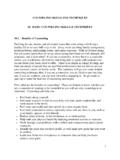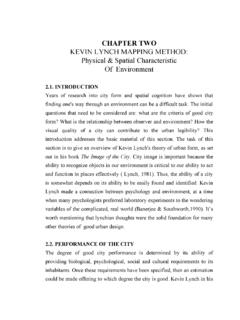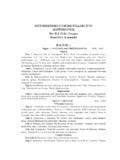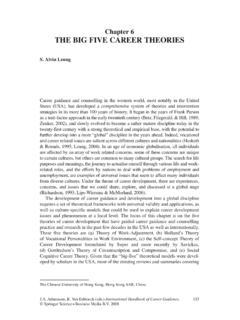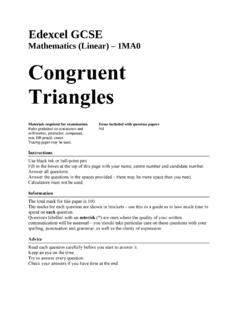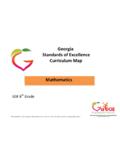Transcription of The Congruence Model A Roadmap for Understanding ...
1 The Congruence Model A Roadmap for UnderstandingOrganizational PerformanceThe critical first step in designing and leadingsuccessful large-scale change is to fully understand the dynamics and performance of the enterprise. It s simply impossible to prescribe the appropriate remedy without firstdiagnosing the nature and intensity of an organization s , all too often, senior leaders particularlythose who have just recently assumed theirpositions or joined a new organization reactprecipitously to a presenting set of quickly spot apparent similaritiesbetween the new situations they face andproblems they ve solved in the past, and leapto the assumption that what worked beforewill work imperative to act is understandable butoften misguided.
2 Leaders would be welladvised to heed the advice of Henry Schacht,who successfully led large-scale change as CEO of both Cummins Engine and LucentTechnologies: Stop, take a deep breath, giveyourself some time, and get the lay of theland before leaping to assumptions aboutwhat should be changed, and s easier said than done. Without a comprehensive Roadmap a Model for Understanding the myriad performance issues at work in today s complex enterprises,leaders are likely to propose changes thataddress symptoms, rather than causes. Thereal issues that underlie an organization s performance can easily go undetected by managers who view each new, unique set ofproblems through the well-worn filter of theirpast experiences and personal , the mental Model any leaderuses to analyze organizational problems willinevitably influence the design of a solutionand, by extension, its ultimate there are countless organizationalmodels, our purpose here is to describe oneparticular approach the Congruence Model of organizational behavior.
3 We ve found thecongruence Model to be particularly useful in helping leaders to understand and analyzetheir organizations performance. Thisapproach has been developed and refined over nearly three decades of academic researchand practical application in scores of majorcompanies. It doesn t provide any pat answersor pre-packaged solutions to the perplexingissues of large-scale change. Instead, it is auseful tool that helps leaders understand theinterplay of forces that shape the performanceof each organization, and starts them down the path of working with their own people todesign and implement solutions to their organization s unique this paper, we ll describe the congruencemodel and suggest how it can provide a starting point for large-scale change.
4 It hasproven to be useful in so many widely varyingsituations because it meets the test of any successful Model : It simplifies what is inher-ently complicated, reduces the complexity of organizational dynamics to manageable proportions, and helps leaders not only tounderstand, but also to actually predict, themost important patterns of organizationalbehavior and the Model DevelopedThe organizational Model most of us carry inour head is the age-old pyramid-shaped tableof organization that typified institutions as oldas the Roman Legions. That Model was fineTHE Congruence MODEL1 2003 Mercer Delta Consulting, LLC.
5 All rights reserved. These materials or parts thereof shall not be reproduced in anyform without written consent of Mercer Delta Consulting, when the pace of institutional changewas measured in decades, even through the first half of the 20th century,organizations changed so slowly that theiressence could be captured in neat patterns of lines and in recent decades, the rapidly acceleratingpace of change has made that static modelobsolete. The old Model merely documentedhierarchical arrangements; the new modelshave to capture the dynamics of fluid relation-ships. The old Model provided a reasonablyclear snapshot of a moment in time; today,we need real-time, streaming new approach to Understanding organ-izations really started in the 1960s, whenresearchers at the Harvard Business Schooland the University of Michigan began exploringthe similarities between naturally occurringsystems and human organizations.
6 They discovered some striking parallels. In verybasic terms, both take input from their surrounding environment, subject it to aninternal transformation process, and producesome form of output (see Figure 1). In addition,both have the capacity to create and use feedback; in other words, they can use theiroutput to alter their input and refine theirinternal , it wasn t until the mid-1970s thatsystems theory found wide acceptance amongstudents of organizations. Building upon theimportant work of earlier theorists (Daniel Katzand Robert Kahn, Jay Lorsch and Alan Sheldon,and John Seiler), David Nadler and MichaelTushman at Columbia University developed asimple, pragmatic approach to organizationdynamics based on systems theory.
7 At roughlythe same time, Harold Leavitt at StanfordUniversity and Jay Galbraith at MIT weresimultaneously grappling with the sameissues. Nadler and Tushman s efforts led to thedevelopment and refinement of the approachnow known as the Congruence Congruence Model suggests that in order tofully understand an organization s performance,you must first understand the organization as a system that consists of some basic elements:THE Congruence MODEL2 Figure 1: The Basic Systems ModelInputTransformationProcessFeedbackO utput The input it draws from both internal andexternal sources The strategy it employs to translate its visioninto a set of decisions about where and howto compete, or, in the case of a governmentagency, the public policy results it wants to achieve Its output the products and services it createsin order to fulfill its strategic objectives The critical transformation process throughwhich people, working within the context of both formal and informal arrangements.
8 Convert input into outputThe real issue is how the interaction of thesecomponents results, for good or ill, in some level of performance. So it s important to beclear about the nature of each component andits role in the organizational Organizational ComponentsInputAn organization s input includes the elementsthat, at any point in time, constitute the set of givens with which it has to work. There arethree main categories of input, each of whichaffects the organization in different ways (see Figure 2).1. The environment: Every organization existswithin and is influenced by a larger envi-ronment, which includes people, otherorganizations, social and economic forces,and legal constraints.
9 More specifically, theenvironment includes markets (clients orcustomers); suppliers; governmental andregulatory bodies; technological, economic,and social conditions; labor unions; competi-tors; financial institutions, and special-interest groups. The environment affectsorganizations in three ways:THE Congruence MODEL3 All factors, includinginstitutions, groups,individuals, events, etc., outside of theboundaries of theorganization beinganalyzed, but having a potential impact onthat demands does the environment make on theorganization?To what extent does the environmentput constraintson organizational action?
10 Various assets the organization has access to, including humanresources, technology, capital, information,etc., as well as less tangible resources(recognition in the market, etc.).What is the relative quality of thedifferent resourcesthat the organization has access to?To what extent are resources fixed, as opposed to flexiblein their configuration?The patterns of past behavior, activity,and effectiveness ofthe organization thatmay have an effecton current organiza- tional have been the major stages or phasesof development ofthe organization?What is the current impact of historicalfactors such as:Strategic decisions?


